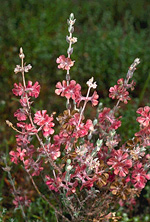 |
This is a cosmopolitan family, especially characteristic of saline and calcareous deserts and saltmarshes throughout the world. In Australia, many members of the family are often the dominant plants in coastal and inland saltmarshes, and on the extensive saline and calcareous saltbush plains in arid southern areas. They are relatively rare in the tropics, and absent from closed forests and the alps.
Characteristic features of the family Chenopodiaceae in Australia include: - chiefly shrubs, occasionally annual or perennial herbs, without stipules
- leaves simple, often grey-green and covered with minute bladder-shaped hairs or salt encrustation, sometimes fleshy, occasionally absent
- flowers small, green or purplish and inconspicuous, with a single whorl of perianth parts; stamens usually 5 and carpels 2, fused to form a single locule
- fruits various, usually more prominent than the flowers, often enlarged and becoming brightly coloured, woody, papery or succulent, sometimes with spines or wings
Description
Evergreen shrubs, annual or perennial terrestrial herbs, or rarely aquatic herbs rooted in the substrate with their leaves emergent. Perennating by rhizomes or taproots. Leaves sometimes ±absent and the stems succulent. Internal secretions not obvious. Plants glabrous, or with simple or dendritic, glandular or non-glandular, unicellular or uniseriate hairs, or mealy. Leaves well developed or much reduced (i.e. to scales, etc.), alternate and spiral, or opposite, or if herbs then cauline or rarely both basal and cauline, petiolate, subsessile or sessile. Stipules absent. Lamina simple, symmetric, trigonous or terete, pinnatifid or pinnatisect, filiform, acicular, subulate, linear, lanceolate, ovate, elliptic, oblanceolate, ovate, oblong or orbicular; base cuneate, rounded or hastate or sagittate; margins entire, dentate or serrate or sinuate, ±flat; one-veined, or the venation pinnate, with the midrib inconspicuous, and the tertiary venation not reticulate; surfaces not punctate; herbaceous, succulent or hard and spinose; distinctive odour absent or aromatic or foetid. Male and female flowers occurring on the same plant or on separate plants, or with all the flowers bisexual. Inflorescences terminal, axillary or rarely intercalary, consisting of glomerules, spikes, panicles, cymes or solitary flowers. Bracts and bracteoles present or absent. Pollination by insects or wind. Flowers odourless or malodorous; sessile or stalked. Floral disc present or absent; nectaries absent. Calyptra rarely present. Perianth regular, of 1 whorl only, with 1–5, free or fused, sepaloid segments, imbricate in bud, cup-shaped, bell-shaped or urn-shaped, green; without contrasting markings, herbaceous, succulent or papery; base with wings or other appendages, or without appendages. Fertile stamens 1–5, opposite to and free of the perianth segments, free of the ovary and style, distinct from each other, all ±equal. Anthers basifixed or dorsifixed, versatile, opening inwards by longitudinal slits, 2-celled. Ovary superior and sessile or rarely half-inferior. Carpels 2–3, apparently fused; ovary with 1 locule. Style terminal, rarely eccentric, single and branched above or from the base. Ovule 1, sessile; placentation basal. Fruit formed from a single flower or several flowers (composite), dry or fleshy, dehiscent or indehiscent; a circumscissile capsule, achene, nut, utricle or berry; the perianth on the maturing fruit deciduous, dry and persistent or growing larger. Disseminule macro-surface featureless, or with straight or hooked hairs, wings or spines; micro-surface ±smooth, spinulose, tuberculate, papillate, rugose or verrucose, cream, brown, grey or black, glossy or dull. Seeds 1 per fruit. Aril absent. Cotyledons 2. Embryo straight, curved or coiled.
(Note: this description has been generated from the coded data compiled for the key. Any errors in the key data will be reflected in the descriptions.)
A treatment of the family Chenopodiaceae has been published in:
Flora of Australia 4: 81-317.
Australian genera of Chenopodiaceae (as recognised for the Flora of Australia)
† = some species native, others introduced
* = all species introduced
†Atriplex
Babbagia
*Bassia
*Beta
†Chenopodium
*Cycloloma
Didimanthus
Dissocarpus
Dysphania
Einadia
Enchylaena
Eremophea
Eriochiton
Halosarcia
*Kochia
Maireana
Malacocera
*Monolepis
Neobassia
Osteocarpum
Pachycornia
Rhagodia
Roycea
*Salsola
Sarcocornia
Scleroblitum
Sclerochlamys
Sclerolaena
Sclerostegia
*Spinacia
Stelligera
†Suaeda
Tecticornia
Tegicornia
Threlkeldia

|
  |

Atriplex lindleyi (flowers and fruit)
Photo: M.Fagg © ANBG

Chenopodium auricomum (flowers)
Photo: M.Fagg © M.Fagg

Chenopodium nitrariacum (flowering branch)
Photo: M.Fagg © M.Fagg

Didymanthus roei (fruits)
Photo: M.Fagg © M.Fagg

|
 |
|